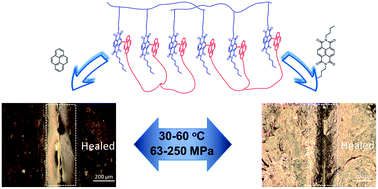Tuning self-healing properties of stiff, ion-conductive polymers†
Abstract
Although various self-healing polymers have been developed, individual designs are generally limited to a narrow range of possible mechanical properties and self-healing temperatures, as it's challenging to tune these characteristics over a wide range without re-engineering the molecular structure entirely. Here, a strategy to decouple self-healing and mechanical properties from the covalent structure of supramolecular polymers and a novel material system developed using this strategy, which is based on non-covalent π–π interactions between naphthalene diimide (NDI) and pyrene (Py) derivatives, are reported. Through targeted, stoichiometric addition of small model compounds, both binding strength and overall density of crosslinking interactions are modulated successfully. This strategy allows us to tune both self-healing temperature (30–60 °C) and Young's modulus (63–250 MPa) of our materials over a wide range, without changing the structure of polymer components. Our self-healing polymer system also displays good solid-state ionic conductivity (>10−5 S cm−1 at room temperature) after doping with Li(G4)TFSI, and could function as a cathode binder in lithium–sulfur batteries to give a high discharge capacity of 1109 mA h g−1 at C/5. The rational design strategy and resultant material platform demonstrated represent a first step towards a class of highly tunable self-healing polymers, for electrochemical devices.



 Please wait while we load your content...
Please wait while we load your content...